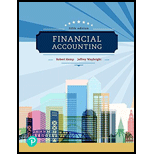
Financial Accounting
5th Edition
ISBN: 9780134728643
Author: Robert Kemp; Jeffrey Waybright
Publisher: Pearson Education (US)
expand_more
expand_more
format_list_bulleted
Concept explainers
Question
Chapter 5, Problem 30BE
1.
To determine
Prepare a perpetual inventory record for the putters to determine the amount of that Incorporation T should report for ending inventory and cost of goods sold using average costing method.
2.
To determine
Journalize the inventory transactions for Incorporation T using the average costing method.
Expert Solution & Answer
Want to see the full answer?
Check out a sample textbook solution
Students have asked these similar questions
Can you explain the correct approach to solve this general accounting question?
The standard materials cost to produce 1 unit of Product S is 5 pounds of material at a standard price of $35 per pound. In manufacturing 9,500 units, 46,800 pounds of material were used at a cost of $36 per pound. What is the total direct materials cost variance?
Define and differentiate between capital expenditure and revenue expenditure. Why is it important for businesses to classify these correctly in financial statements? Support your explanation with at least one example for each type of expenditure.
Chapter 5 Solutions
Financial Accounting
Ch. 5 - Prob. 1DQCh. 5 - How are the financial statements of a manufacturer...Ch. 5 - What is a cost-flow assumption? Why is a cost-flow...Ch. 5 - If a company had two units that cost 1 each in its...Ch. 5 - Prob. 5DQCh. 5 - Prob. 6DQCh. 5 - Prob. 7DQCh. 5 - Prob. 8DQCh. 5 - Prob. 9DQCh. 5 - Prob. 10DQ
Ch. 5 - During April, Bargain Hardware made sales of...Ch. 5 - Prob. 2SCCh. 5 - Prob. 3SCCh. 5 - Prob. 4SCCh. 5 - Prob. 5SCCh. 5 - Prob. 6SCCh. 5 - Prob. 7SCCh. 5 - Prob. 8SCCh. 5 - Prob. 9SCCh. 5 - Prob. 10SCCh. 5 - Prob. 11SCCh. 5 - Prob. 12SCCh. 5 - Prob. 1SECh. 5 - Prob. 2SECh. 5 - Prob. 3SECh. 5 - Prob. 4SECh. 5 - Prob. 5SECh. 5 - Prob. 6SECh. 5 - Prob. 7SECh. 5 - Prob. 8SECh. 5 - Lower-of-cost-or-market rule (Learning Objective...Ch. 5 - Prob. 10SECh. 5 - Inventory principles and terminology (Learning...Ch. 5 - Prob. 12SECh. 5 - Prob. 13SECh. 5 - Prob. 14SECh. 5 - Prob. 15SECh. 5 - Prob. 16AECh. 5 - Prob. 17AECh. 5 - Prob. 18AECh. 5 - Prob. 19AECh. 5 - Prob. 20AECh. 5 - Prob. 21AECh. 5 - Prob. 22AECh. 5 - Prob. 23AECh. 5 - Prob. 24AECh. 5 - Prob. 25AECh. 5 - Prob. 26AECh. 5 - Prob. 27AECh. 5 - FIFO (Learning Objective 2) 10-15 min. Tee Time,...Ch. 5 - LIFO (Learning Objective 2) 10-15 min. Refer to...Ch. 5 - Prob. 30BECh. 5 - Prob. 31BECh. 5 - Prob. 32BECh. 5 - Prob. 33BECh. 5 - Prob. 34BECh. 5 - Prob. 35BECh. 5 - Prob. 36BECh. 5 - Prob. 37BECh. 5 - Prob. 38BECh. 5 - Prob. 39BECh. 5 - Computing LIFO and journalizing inventory...Ch. 5 - Prob. 41APCh. 5 - FIFO, LIFO, and average cost (Learning Objectives...Ch. 5 - Prob. 43APCh. 5 - Prob. 44APCh. 5 - Prob. 45APCh. 5 - Estimating ending inventory (Learning Objective 7)...Ch. 5 - Prob. 47APCh. 5 - Prob. 48BPCh. 5 - Prob. 49BPCh. 5 - FIFO, LIFO, and average cost (Learning Objectives...Ch. 5 - Prob. 51BPCh. 5 - Prob. 52BPCh. 5 - Prob. 53BPCh. 5 - Prob. 54BPCh. 5 - Prob. 55BPCh. 5 - Continuing Exercise This exercise continues the...Ch. 5 - Prob. 1CPCh. 5 - Prob. 1CFSAPCh. 5 - Prob. 1EIACh. 5 - Prob. 2EIACh. 5 - Prob. 1FACh. 5 - Prob. 1IACh. 5 - Prob. 1SBACh. 5 - Prob. 1WCCh. 5 - Comprehensive Problem The Accounting Cycle for a...
Knowledge Booster
Learn more about
Need a deep-dive on the concept behind this application? Look no further. Learn more about this topic, accounting and related others by exploring similar questions and additional content below.Similar questions
- When preparing the trial balance, the accountant of Zenith Co. noticed that the debit column exceeded the credit column by $1,000. Which of the following errors could cause such an imbalance? A) A transaction not recorded at all B) Reversing the debit and credit C) Posting an amount twice to the debit side D) Recording a sale as a purchase MCQarrow_forwardI am looking for the correct answer to this general accounting question with appropriate explanations.arrow_forwardDon't use AIarrow_forward
- General accountingarrow_forwardWhat are the required sales?arrow_forwardLuma Corp. had net credit sales of $2,400,000 in 2023. The beginning accounts receivable balance was $180,000, and the ending balance was $210,000. (a) What is the receivables turnover? (b) What is the average collection period in days?arrow_forward
arrow_back_ios
SEE MORE QUESTIONS
arrow_forward_ios
Recommended textbooks for you
- Century 21 Accounting Multicolumn JournalAccountingISBN:9781337679503Author:GilbertsonPublisher:Cengage

Century 21 Accounting Multicolumn Journal
Accounting
ISBN:9781337679503
Author:Gilbertson
Publisher:Cengage

INVENTORY & COST OF GOODS SOLD; Author: Accounting Stuff;https://www.youtube.com/watch?v=OB6RDzqvNbk;License: Standard Youtube License